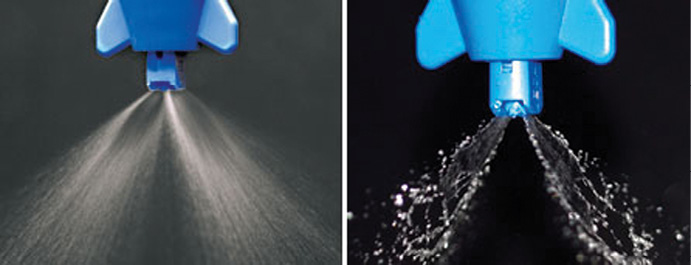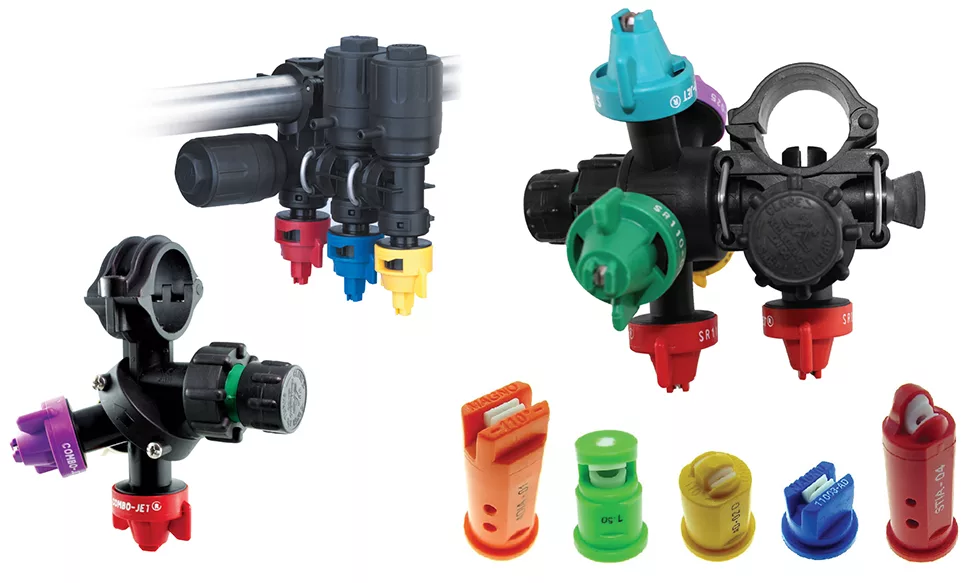Photo above: Each nozzle type is designed for a specific type of target and application. For example, a nozzle designed for broadcast spraying is not good for spraying pesticides over a narrow band.
Nozzles are typically the least costly items on a sprayer, but they are key to the final outcome from a spraying job: achieving maximum efficacy from the pesticide applied while reducing the off-target (drift) movement of pesticides to a minimum. Pesticides work well if the rates on labels are achieved during application. This can be achieved only if the right nozzle type and the proper size of the nozzles are on the sprayer — and the sprayer is operated properly.
If an equipment dealership handles sprayers, it must be equipped to support its customers in the selection of the proper nozzles to achieve desired results while using a minimum amount of pesticides or fertilizer. Expertise in this area of sprayer operations will immediately increase a dealer’s value to his or her farm customers.
Selecting the best nozzle requires careful consideration of all the factors listed here:
- Sprayer operation parameters (application rate, spray pressure, travel speed)
-
Type of chemical sprayed:
- Fertilizers and growth regulators
- Fungicides
- Insecticides
- Herbicides (soil incorporation, pre/post emergence)
- Spray coverage requirements: contact, systemic
- Application type: broadcast, band, directed, air assisted
- Target crop: field crops, vegetables, vineyard, shrubs and trees, etc.
- Spray drift risk
- Label requirements and restrictions

Some spray nozzles are designed for delivering liquids at different rates depending upon conditions and requirements. Along with normal spraying, this nozzle can also be used for spraying in sub-optimal weather conditions to reduce drift. Photo Courtesy of hardi
Air Flow at the Boom
While it doesn’t use sophisticated computer technology, K-B Agritech LLC’s Pattern Master is helping growers improve their spray coverage by reducing wind shear caused by a sprayer’s boom as it passes through the air at field speeds.
Kurt Kamin, co-owner of K-B Agritech, says a sprayer moving at 12 mph ground speed — even in a dead calm — will create a high pressure area in front of the boom, so there may be a relative wind of 15-16 mph moving over the boom and flowing back to hit the spray pattern.
“That shear is turbulence and it will affect the accuracy of your spray delivery,” he says.
The Pattern Master is a patented aluminum plate shaped somewhat like an airfoil with a brush on the bottom mounted ahead of the sprayer nozzles. The device deflects pressure-related turbulence, allowing the spray to land where it is intended and not drift away, he explains.
Selecting Nozzle Types
Each nozzle type is designed for a specific type of target and application. For example, a nozzle designed for broadcast spraying is not good for spraying pesticides over a narrow band. Most nozzle manufacturers provide detailed charts showing which nozzle type is best for a specific job.
Although the apps and tables in catalogs may expedite the nozzle size selection process, it is best to understand the process and the math nozzle manufacturers use to generate the values listed in tables and to generate nozzle recommendations in their apps.
The following steps must be taken to determine the nozzle flow rate (gpm):
Step 1. Select the application rate in gallons per acre (gpa). This is a decision based on pesticide label recommendations, field conditions and water supply.
Step 2. Select a practical and safe ground speed in miles per hour (mph).
Step 3. Determine the spray width per nozzle (W).
- For broadcast applications, W = nozzle spacing (distance between two nozzles on the boom) in inches.
- For band spraying, W = band width in inches.
- For directed spraying, W = row spacing in inches (or band width) divided by the number of nozzles per row (or band).
Step 4. Determine the flow rate (gpm) required from each nozzle by using the following equation:

(5,940 is a constant to convert gpa, mph and inches to gpm)
Step 5. Select a nozzle size from the manufacturer’s catalog that will give the flow rate (gpm) determined in Step 4 when the nozzle is operated within the recommended pressure range. If a nozzle of this size is not available, change the travel speed in the equation above and determine the new flow rate required.
For example, the grower wants to spray a pre-emergence herbicide at 15 gpa, at a speed of 8 mph. The distance between the nozzles on the boom is 20 inches. The herbicide label requires a spray quality of “Medium.” What should be the flow rate of the chosen nozzle?

Since this is a broadcast application (pre-emergence), W is the distance between nozzles (W = 20 inches). Filling in the variables yields the following calculation:

This means, to apply 15 gpa at a speed of 8 mph with this sprayer setup, we need to select a nozzle with a flow rate of 0.4 gpm.
Once you determine the required flow rate of the nozzle, check the nozzle catalog to make sure the nozzle will produce “medium” spray quality.
Special Report Table of Contents
Can Application Technologies Reduce Ag Input Costs?
Three years of low grain prices are forcing farmers to minimize production costs. Developments in how they apply inputs will be an important part of growers’ cost cutting.
Making a Case for Curbing Spending on Inputs
Few signs point to a recovery in crop prices in the near term, which is making it imperative growers find ways to hold down costs.
What’s Trending in Ag Application Technology?
Developments in applying crop nutrients and pesticides have come fast and furious during the last decade. Many of the newest breakthroughs are aimed at ‘site-specific’ management of inputs, nozzles and individual nozzle control, and soil applications.







